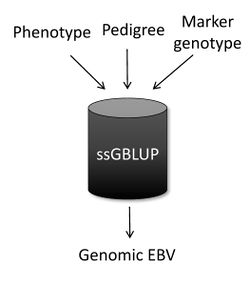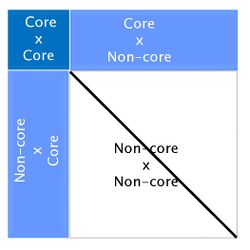Genetic Evaluation
EPD
Utility (compared to actual/adjusted phenotypes, ratios, disjoined marker scores, etc.) (Suggested writer: Megan Rolf)
Basic Models
BLUP
Single-step Genomic BLUP
Single-step genomic BLUP (ssGBLUP) Cite error: The opening <ref> tag is malformed or has a bad name Cite error: The opening <ref> tag is malformed or has a bad name is a method developed to enable the inclusion of marker genotypes into the well-known BLUP machinery. The idea of ssGBLUP came from the fact that only a small portion of the animals in the pedigree is genotyped. In this way, one approach to account for all animals (i.e., genotyped and non-genotyped) in the evaluation would be to combine pedigree and genomic relationships and use this as the covariance structure in the BLUP mixed model equations. Thus, ssGBLUP uses marker information to construct genomic relationships.
Legarra et al. (2009) Cite error: The opening <ref> tag is malformed or has a bad name stated that genomic evaluations would be simpler if genomic relationships were available for all animals in the model. Then, their idea was to look at the pedigree relationship as a priori relationship and at the genomic relationship as the observed relationship. Based on that, they showed the genomic information could be extended (i.e., imputed) to non-genotyped animals. This means that in ssGBLUP pedigree relationships for non-genotyped animals are enhanced by the genomic information of their relatives. The relationship matrix that combines information for genotyped and non-genotyped animals is represented by H:
Where the subscripts 1 and 2 refer to non-genotyped and genotyped animals, respectively. A is the pedigree relationship matrix and G is the genomic relationship matrix computed based on markers. If M is a matrix of marker genotypes centered for allele frequency (p) and has the dimension of number of animals by number of SNP (N), G is computed as Cite error: The opening <ref> tag is malformed or has a bad name:
Although H is very complicated, H-1 is quite simple Cite error: The opening <ref> tag is malformed or has a bad name:
If we replace A-1 by H-1 in the BLUP mixed model equations, we have ssGBLUPCite error: The opening <ref> tag is malformed or has a bad name:
Where b and u are vectors of fixed effects and breeding values, respectively; X and Z are incidence matrices for the effects in b and u; y is a vector of phenotypes, and λ is the ratio of residual to additive genetic variance. As a combined relationship is used in ssGBLUP, the output for each animal is automatically a genomic EBV, and the mixed model equations above can be simplistically represented as:
The genomic EPD is then calculated as:
When the subject is genetic evaluation, one of the most common questions is “What is the main difference among ssGBLUP, BLUP, and genomic BLUP (GBLUP)?” In a nutshell, ssGBLUP uses phenotypes, pedigree, and genotypes for both genotyped and non-genotyped animals, whereas BLUP uses phenotypes and pedigree for all animals and GBLUP uses phenotypes and genotypes only for genotyped animals.
In the US, ssGBLUP has been used for genomic evaluation of beef and dairy cattle, pigs, chickens, and fish. Regarding to beef cattle, Angus Genetics Inc. runs ssGBLUP evaluations for American Angus and Charolais, Canadian Angus, Red Angus, and Charolais, and Maine Anjou. Moreover, Livestock Genetic Services (A Neogen Company) runs ssGBLUP evaluations for Santa Gertrudis. For more information about ssGBLUP for beef cattle evaluation check Lourenco et al. (2015)Cite error: The opening <ref> tag is malformed or has a bad name, Lourenco et al. (2017) Cite error: The opening <ref> tag is malformed or has a bad name, and Misztal & Lourenco (2018) Cite error: The opening <ref> tag is malformed or has a bad name.
ssGBLUP for large genotyped populations
Running ssGBLUP evaluations for large genotyped populations can be a huge computational challenge. This is because the construction of H-1 requires the construction and inversion of G. Matrix inversion has a cubic computational cost, requiring a large amount of memory. As an example, inverting G for 100,000 animals requires about 300Gb of memory and takes over 2 hours.
The algorithm for proven and young (APY) was proposed by Misztal et al. (2014) Cite error: The opening <ref> tag is malformed or has a bad name to overcome this computing limitation of ssGBLUP, and was based on Henderson’s algorithm to construct A-1 Cite error: The opening <ref> tag is malformed or has a bad name. In APY, G-1 is constructed directly, avoiding the matrix inversion step. In this algorithm, genotyped animals are split into two groups: core (c) and non-core (n). Breeding values of non-core animals are then calculated as functions of breeding values of core animals and the genomic relationships between core and non-core. If the number of genotyped animals surpasses 100,000, using APY G-1 in ssGBLUP is highly recommended.
Constructing APY G-1 is computationally efficient because it requires only the inversion of a block of G that contains relationships between core animals:
Where Mnn-1 is the Mendelian error. Although this formula looks complicated, a simple graphic representation of APY G-1 is:
Looking at the above figure it is easy to see that relationships between non-core animals are ignored in APY. However, this does not have an impact on breeding values. Several studies have reported correlations greater than 0.99 between genomic EPD from regular ssGBLUP and from ssGBLUP with APY G-1 Cite error: The opening <ref> tag is malformed or has a bad name Cite error: The opening <ref> tag is malformed or has a bad name Cite error: The opening <ref> tag is malformed or has a bad name.
Genomic EPD accuracy in ssGBLUP
When datasets are very large, using the inverse of the left-hand side of the ssGBLUP mixed model equations to calculate accuracy of genomic EPD is impeditive. Sampling techniques or approximations Cite error: The opening <ref> tag is malformed or has a bad name Cite error: The opening <ref> tag is malformed or has a bad name can help to overcome this limitation. The approximated genomic EPD accuracy developed by the Animal Breeding and Genetics Group at University of Georgia combines contributions from phenotypes and pedigree Cite error: The opening <ref> tag is malformed or has a bad name with contribution from genomic relationships. To reduce computing time, only coefficients from the diagonal of G are used in the formula to compute genomic contribution.
Marker effects in ssGBLUP
Although the marker information in ssGBLUP is used to construct genomic relationships, it is possible to calculate SNP effects once we obtain genomic EBV (Wang et al., 2012Cite error: The opening <ref> tag is malformed or has a bad name, Lourenco et al., 2015Cite error: The opening <ref> tag is malformed or has a bad name. Marker effects can be then used to calculate predictions based only on marker genotypes for young genotyped animals that are not yet or will never make into an official evaluation.
Cite error: <ref> tag defined in <references> has group attribute "" which does not appear in prior text.
Cite error: <ref> tag defined in <references> has group attribute "" which does not appear in prior text.
Cite error: <ref> tag defined in <references> has group attribute "" which does not appear in prior text.
Cite error: <ref> tag defined in <references> has group attribute "" which does not appear in prior text.
Cite error: <ref> tag defined in <references> has group attribute "" which does not appear in prior text.
Cite error: <ref> tag defined in <references> has group attribute "" which does not appear in prior text.
Cite error: <ref> tag defined in <references> has group attribute "" which does not appear in prior text.
Cite error: <ref> tag defined in <references> has group attribute "" which does not appear in prior text.
Cite error: <ref> tag defined in <references> has no name attribute.
Cite error: <ref> tag defined in <references> has no name attribute.
Cite error: <ref> tag defined in <references> has no name attribute.
Cite error: <ref> tag defined in <references> has no name attribute.
Cite error: <ref> tag defined in <references> has no name attribute.
Cite error: <ref> tag defined in <references> has no name attribute.
Single-step Hybrid Marker Effects Models (Suggested writer: Bruce Golden)
Interim Calculations
Bias
(in)complete reporting / contemporary groups / preferential treatment (Suggested writer: Bob Weaber
Accuracy (Suggested writer: Matt Spangler)
meaning of accuracy
what impacts accuracy
different definitions of accuracy (true, BIF, reliability)
Variance components (Suggested writer: Steve Kachman)
Impact on EPD, accuracy, genetic gain (Suggested writer: Steve Kachman)
Heterogeneous variance
Connectivity (Suggested writer: Ron Lewis)
Measures of (Suggested writer: Ron Lewis)
==Impact on GE== (Suggested Writer: Ron Lewis)







